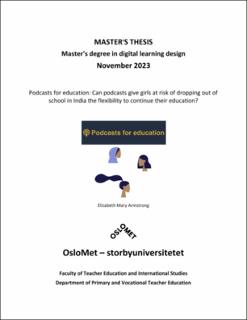Podcasts for education: Can podcasts give girls at risk of dropping out of school in India the flexibility to continue their education?
Master thesis
Published version
Permanent lenke
https://hdl.handle.net/11250/3121135Utgivelsesdato
2023Metadata
Vis full innførselSamlinger
Sammendrag
This design thesis explores the intersection of education, technology, and social justice with a focus on improving the educational opportunities for girls in secondary schools in India. Motivated by the persistent challenges faced by girls in the country, such as high dropout rates due to child marriage and domestic responsibilities, the aim of the study is to create a web resource for teachers working with girls at risk of dropping out and explore whether it can address the issues found in the literature. The thesis is grounded in the belief that podcasting, as a flexible and accessible medium, has the potential to address these challenges. The central question guiding this research is whether podcasts can provide flexibility for girls at risk of dropping out, enabling them to continue their education. The goal is to develop a user-friendly, responsive website offering teachers guidance on creating educational audio content. The design of this is heavily influenced by literature and research on the topics of girls’ education, technology in India, and the various practical and linguistic barriers and limitations faced by users in this demographic. The thesis is structured to include a literature review, providing an academic foundation for the research, followed by chapters detailing the design methodology and insight into design science as a research approach, description of the design process, and evaluation of the prototype. It concludes with insights into the project's potential contribution to the field and suggests points for further research and development. The prototype is made using the design thinking method, but unfortunately, real users weren’t available during the process. The conclusion is that the web resource that has been made has the potential to be beneficial for teachers, but that further testing with a user base would be ideal. Either way the work hopes to represent a step towards leveraging technology to bridge educational gaps and contribute to the broader global agenda of sustainable development.
